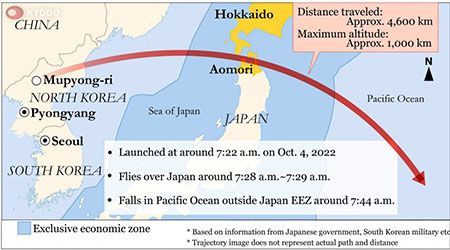Special to WorldTribune.com
In a strange but not unexpected twist to a world in turmoil, North Korea’s bellicose leadership has carried out a series of missile tests, not seen since 2017. One particularly provocative firing of an intermediate range rocket flew right over Japan. Two short range missiles were shot into the sea on the eve of U.S. Vice President Kamala Harris’s visit to South Korea and the DMZ.
So what’s going on in Kim Jong-Un’s reclusive and quaintly titled Democratic People’s Republic of Korea (DPRK)?
As in a well-practiced drill, diplomats convened in the UN Security Council for yet additional crisis consultations. Only last month North Korea, largely unnoticed in the flurry of the Ukraine war and global food crisis, declared that it was an “irreversible” nuclear power.
The missile firings may be a prelude for the communist regime to soon carry out its seventh nuclear test.
 “In just nine days, the DPRK has launched eight ballistic missiles, all clear violations of multiple Security Council resolutions,” stated U.S. UN Amb. Linda Thomas-Greenfield. She warned, “Pyongyang clearly feels emboldened. The DPRK has launched 39 ballistic missiles this year alone, which far surpasses its previous record of 25.”
“In just nine days, the DPRK has launched eight ballistic missiles, all clear violations of multiple Security Council resolutions,” stated U.S. UN Amb. Linda Thomas-Greenfield. She warned, “Pyongyang clearly feels emboldened. The DPRK has launched 39 ballistic missiles this year alone, which far surpasses its previous record of 25.”
France’s delegate Nicolas de Riviere stated poignantly, “The increase in ballistic (missile) tests since the beginning of the year is unprecedented. We are witnessing a clear development of ballistic capabilities, with the stated intention of developing a tactical nuclear program.”
He added, “It would be irresponsible to reward violations of the resolutions by easing sanctions. Instead, pressure on Pyongyang must be maintained and increased in certain areas.”
The International Atomic Energy Agency (IAEA) reported indications that North Korea’s Pungyee-rii Nuclear test site remained active and may be preparing for the DPRK’s seventh nuclear test.
UN Assistant Secretary General Khaled Khiari, told assembled delegates, “the Secretary General strongly condemns the DPRK’s launch of a long-range ballistic missile. This was a reckless act and a clear violation of relevant Security Council resolutions.” He added, “This launch risks triggering a significant escalation of tensions in the region and beyond.”
The recent Hwasong-12 rocket firing over Japan’s Northern Hokkaido island traveled 2,800 miles before falling into the Pacific. It was the North’s first launch over the Japanese home islands since 2017.
Related: U.S. requires increased theater nuclear weapons after N. Korean missile exercises, October 11, 2022
In a toughly-worded statement, but not a formal Security Council resolution, the United States, along with ten other countries including Albania, Brazil, France, India, Ireland, Japan, Norway, the Republic of Korea, the United Arab Emirates and the United Kingdom, “strongly condemn the DPRK’s long-range ballistic missile launch which overflew Japan on Oct. 4 and its seven other ballistic missile launches conducted since September 25.”
“These launches violate multiple Security Council resolutions and pose a threat to not only the region, but to the entire international community,” the statement underscored.
As Amb. Thomas-Greenfield said earlier, “But as we all know, the DPRK has enjoyed blanket protection from two members of this Council. These two members have gone out of their way to justify the DPRK’s repeated provocations.” That’s naturally Russia and China.
The statement added, “Following the DPRK’s provocations and escalatory behavior in 2017, the Council came together and unanimously took action to hold the DPRK accountable for its unlawful actions.”
|
Though many observers thought using the refrain of “little rocket man” signaled a certain conflict, Trump soon turned the tables and made it a prelude to the historic face-to-face Singapore Summit. |
That confrontation with the then-new Trump Administration came to the brink of “Fire and Fury” warnings when the new American president called Kim’s bluff.
Though many observers thought using the refrain of “little rocket man” signaled a certain conflict, Trump soon turned the tables and made it a prelude to the historic face-to-face Singapore Summit.
More diplomacy followed as other personal meetings ensued. Significantly, North Korea’s Kim refrained from his provocative missile diplomacy for more than three years!
That’s now been changing since early 2021. Pyongyang state run media says that its recent missile launches were a “simulation” of a nuclear attack on South Korean and U.S. targets.
But somehow, I feel that beyond lofty geopolitical calculations, Kim Jong-Un misses an audience, where he probably relishes the role of a Bond Bad Guy. Vladimir Putin’s Ukraine war has totally shifted much of the spotlight to Europe. As for East Asia, it’s his longtime mentor in China Xi Jinping threatening Taiwan. Kim is odd man out.
Kim Jong-Un may carry out his seventh nuclear test at some point between China’s upcoming 20th Communist Party Congress (from Oct. 16) and the American mid-term Congressional Elections on Nov. 8.
So, in a bizarre sense, it’s maybe, “Don’t forget Me, I’m right here.”
John J. Metzler is a United Nations correspondent covering diplomatic and defense issues. He is the author of Divided Dynamism the Diplomacy of Separated Nations: Germany, Korea, China (2014). [See pre-2011 Archives]

 By
By